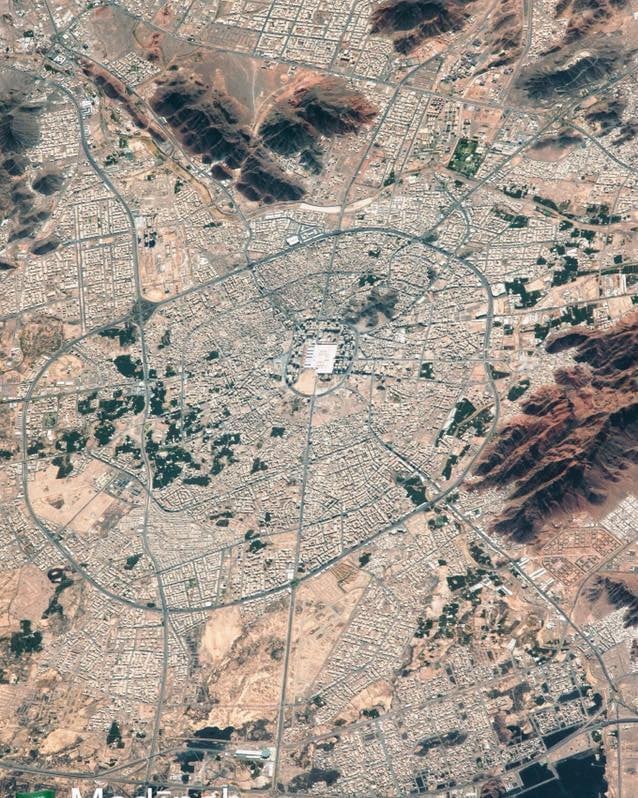By Shahabuddin Amerudin
The satellite image provided offers a breathtaking aerial view of Medina, one of the holiest cities in Islam. Located in the Hejaz region of Saudi Arabia, Medina is a city steeped in religious significance and historical importance. At the heart of this image lies Al-Masjid an-Nabawi, the Prophet’s Mosque, which is the focal point of the city both spiritually and geographically. The mosque, easily identifiable by its sprawling courtyards and multiple minarets, is one of the most revered sites in Islam, second only to the Masjid al-Haram in Mecca.
Surrounding the mosque, the urban layout of Medina unfolds in a radial pattern, with roads extending outward like spokes on a wheel. This pattern is indicative of the city’s development, which has historically centered around the Prophet’s Mosque. The image captures a blend of the old and the new, with the densely built-up areas closer to the mosque reflecting the city’s ancient roots, while the more spacious, organized developments on the outskirts signal modern urban planning. The city is framed by rugged mountains and desert terrain, particularly visible in the upper corners of the image, highlighting the geographical challenges and natural beauty that characterize the region.
Medina is not just a historical site; it is a living, breathing city where religious activities dominate daily life. The Prophet’s Mosque is a pilgrimage destination for millions of Muslims each year, particularly during Hajj and Umrah seasons. The city bustles with religious tourists who come to pray, visit the tomb of the Prophet Muhammad, and experience the spiritual atmosphere of one of Islam’s most sacred places. Beyond the religious sphere, Medina functions like any other city, with its residential neighborhoods, markets, schools, and hospitals providing services to its local population.
As the image suggests, Medina’s urban expansion is ongoing, with development likely to continue along the existing road networks and into less mountainous areas. However, this expansion must be carefully managed to preserve the city’s historical and religious heritage. The mountainous terrain poses natural barriers to growth, while the need to maintain the sanctity of religious sites places additional constraints on urban development. Nonetheless, Medina’s growth over the past few decades has been remarkable, driven by its religious significance and the influx of visitors from around the world.
Historically, Medina was a small oasis town, but its fortunes changed dramatically in 622 CE, when Prophet Muhammad migrated from Mecca in an event known as the Hijra. This migration marked the beginning of the Islamic calendar and transformed Medina into the epicenter of the Islamic world. The Prophet’s Mosque was originally built on the site of the Prophet’s house, and it has since been expanded and modernized to accommodate the growing number of worshippers. The city’s history is intricately linked to the rise of Islam, and its streets and buildings are a living testament to the faith’s early years.
This satellite image of Medina offers more than just a glimpse of a city; it provides a window into the rich history and ongoing evolution of a place that holds profound significance for Muslims worldwide. As Medina continues to expand and modernize, it remains anchored by its deep historical roots, ensuring that its spiritual legacy endures for generations to come.


